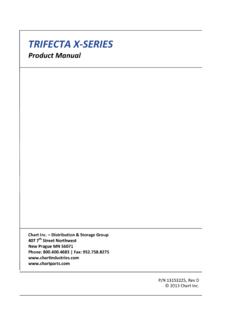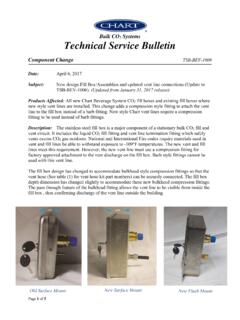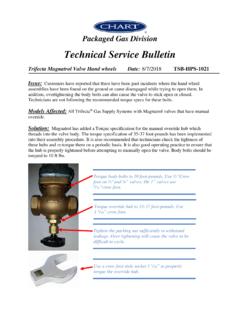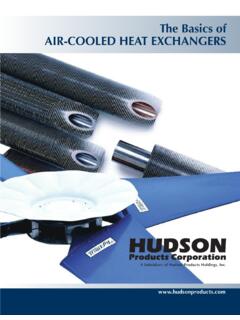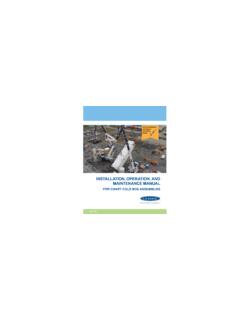Transcription of TECHNICAL MANUAL CARBON DIOXIDE STORAGE TANK
1 TECHNICAL MANUAL CARBON DIOXIDE STORAGE TANK MANUAL # 11650869 Rev I 1 TABLE OF CONTENTS SECTION 1 PREFACE .. 3 GENERAL .. 3 TERMS .. 3 ABBREVIATIONS .. 4 SECTION 2 SAFETY .. 5 GENERAL .. 5 SAFETY BULLETIN .. 6 OXYGEN DEFICIENT ATMOSPHERES .. 7 CARBON DIOXIDE .. 7 SECTION 3 INTRODUCTION .. 10 GENERAL .. 10 RECEIVING CHECK POINTS .. 10 VACUUM CHECK PROCEDURES .. 11 FEATURES .. 11 PHYSICAL DESCRIPTION .. 12 SAFETY DEVICES .. 12 OPERATIONAL SYSTEMS .. 13 FILLING .. 13 PUMP TRANSFER .. 13 PRESSURE BUILDING (Optional) .. 13 PRESSURE REDUCTION .. 14 LIQUID WITHDRAWAL .. 15 GAS WITHDRAWAL .. 15 SECTION 4 INSTALLATION .. 16 GENERAL .. 16 RIGGING .. 16 UNLOADING .. 17 CARGO CONTAINER .. 17 INSPECTION .. 17 RECEIVING CHECKPOINTS .. 18 VACUUM TEST PROCEDURE .. 18 SITE CONSIDERATIONS .. 19 SITE PREPARATION.
2 19 SITE PROTECTION .. 20 OTHER SITE CONSIDERATIONS .. 20 SECTION 5 OPERATIONS .. 21 GENERAL .. 21 PURGING AND FILL CONSIDERATIONS .. 21 TANK PURGING PROCEDURE .. 21 INITIAL (WARM TANK) FILLING PROCEDURES .. 23 PREPARING THE STATION FOR OPERATION .. 24 TANK VENT PRESSURE CONTROL .. 24 REFILLING .. 24 TANK REFILLING PROCEDURE .. 24 VAPOR WITHDRAWAL PROCEDURE .. 25 LIQUID WITHDRAWAL PROCEDURE .. 26 2 SECTION 6 MAINTENANCE .. 27 GENERAL .. 27 COMPATIBILITY AND CLEANING .. 27 CLEANING PROCEDURE FOR BULK CO2 STORAGE tanks .. 27 PERIODIC INSPECTIONS .. 29 SOLDERING/WELDING .. 29 MAINTENANCE CHECKS AND ADJUSTMENTS .. 29 VACUUM INTEGRITY CHECK .. 30 PRESSURE AND LIQUID LEVEL GAUGES CHECKS AND 30 TROUBLESHOOTING .. 31 REPAIR .. 32 VALVE REPAIR .. 33 TANK SAFETY RELIEF VALVE (PSV-1A/1B) .. 33 TESTING AFTER REPAIR .. 34 RETURNING DEFECTIVE COMPONENTS.
3 34 SECTION 7 SPARE PARTS LISTS .. 35 SECTION 8 ILLUSTRATIONS .. 36 OUTLINE & DIMENSION DRAWINGS .. 36 P&ID DRAWING For Specific Tank .. 36 REVISION LOG Rev A (04/17/02) Add HS-6 Ton O&D to MANUAL . Rev B (05/02/02) Add HS-30/50 Ton O&D to MANUAL Rev C (06/03/02) Add HS-14 Ton O&D to MANUAL and also HS-30/50 Ton w/Skid O&D Rev D (08/21/02) Updated O&D C-11694141-A and O&D C-11642957-A Rev E (09/18/02) Add Spare Parts lists, update all O&Ds to include N2O and remove HS-30/50 Ton w/Skid O&D Rev F (12/12/02) Update O&Ds Rev G (4/30/03) Remove Spare Parts List Rev H (4/29/13) Add O&D C-20675488 for FNL HS-30 TON-CC-350-ALAC-W/SKID Rev I (6/18/13) Add O&D C-20693088 for FNL VS-35 TON-CC-350-AL-GLBL 3 SECTION 1 PREFACE GENERAL The CARBON DIOXIDE STORAGE Tank TECHNICAL MANUAL is designed to be used in conjunction with CARBON DIOXIDE STORAGE tanks provided by Chart.
4 This MANUAL contains information regarding the safe operation and handling of liquid CARBON DIOXIDE (CO2) with the CARBON DIOXIDE STORAGE Tankage. It should be thoroughly read and understood by anyone that operates the equipment. If there are any questions regarding the operation of the CARBON DIOXIDE STORAGE Tank, contact Chart s TECHNICAL Service division at 1-800-400-4683. This MANUAL is intended to provide the user with all the necessary information needed to install, operate and maintain the CARBON DIOXIDE STORAGE Tank. The schematics, piping illustrations, and parts list shows a reference number for each component used on the CARBON DIOXIDE STORAGE Tank. The reference numbers may refer to the same functional component between the various models. The reference numbers will be used throughout this MANUAL to draw specific attention to a component while describing its function, operation, or repair.
5 The safety requirements for operating the CARBON DIOXIDE STORAGE Tank and handling or transporting extremely cold liquid products are shown in Sections 2. Use this safety section as a Safety Check-List each time the equipment is being used. Section 3 discusses the general features of the tank and the theory of operation. Section 4 illustrates how to uncrate and install the CARBON DIOXIDE STORAGE Tank. Section 5 gives a step by step procedure for the basic operation of the tank. Section 6 indicates how to maintain and repair the CARBON DIOXIDE STORAGE Tank. Section 7 contains Outline & Dimension drawings and P&ID drawing for the specific tank models covered by this MANUAL . It has general information, TECHNICAL specifications, plumbing schematics, and parts list. It should be reviewed first and referred to as the rest of the MANUAL is read.
6 TERMS Throughout this MANUAL safety precautions will be designated as follows: WARNING - Description of a condition that can result in personal injury or death. 4 CAUTION - Description of a condition that can result in equipment or component damage. NOTE - A statement that contains information that is important enough to emphasize or repeat. ABBREVIATIONS The following abbreviations and acronyms are used throughout this MANUAL : BAR Pressure (Metric) CBM Center Back Mount Gauge CGA Compressed Gas Association CO2 CARBON DIOXIDE FPT Female Pipe Thread MPT Male Pipe Thread NPT National Pipe Thread NR Not Required ODT Outside Diameter Tube Size P/N Part Number PPM Parts per Million PSI Pounds per Square Inch PSIG Pounds per Square Inch (Gauge) SCF Standard Cubic Feet SCM Standard Cubic Meters PB Pressure Builder Nm3 Normal Cubic Meters 5 SECTION 2 SAFETY GENERAL The CARBON DIOXIDE STORAGE Tank consists of an inner pressure vessel encased within and outer CARBON steel vacuum shell.
7 The container operates under low-to-medium pressure. Safety relief devices are used to protect the pressure vessel and vacuum casing, sized and selected in accordance with ASME standards they include a dual relief valve system to protect the pressure vessel, and a reverse buckling rupture disc or lift plate to protect the vacuum casing (outer vessel). The CARBON DIOXIDE STORAGE tanks are designed and engineered for safe reliable operations, and are durable enough to provide many years of trouble-free operation. Strict compliance with proper safety and handling practices is necessary when using a CARBON DIOXIDE STORAGE Tank. We recommend that all our customers re-emphasize safety and safe handling practices to all their employees and customers. While every possible safety feature has been designed into the units and safe operations are anticipated, it is essential that every user of the CARBON DIOXIDE STORAGE Tank carefully read all WARNINGS and CAUTIONS listed and enumerated in this safety section sheet and contained in the MANUAL itself.
8 Also read the information provided in the safety bulletins for CARBON DIOXIDE gas. Periodic review of this safety summary is recommended. WARNING: CARBON DIOXIDE vapors in air may dilute the concentration of oxygen necessary to support or sustain life. Exposure to such an oxygen deficient atmosphere can lead to unconsciousness and serious injury, including death. WARNING: Before removing any parts or loosening fittings, empty the container of liquid contents and release any vapor pressure in a safe manner. External valves and fittings can become extremely cold and may cause painful burns to personnel unless properly protected. Personnel must wear protective gloves and eye protection whenever removing parts or loosening fittings. Failure to do so may result in personal injury due to the extreme cold and pressure in the tank. WARNING: Accidental contact of liquid or solid CO2 with the skin or eyes may cause a freezing injury similar to a burn.
9 Handle liquid so that it will not splash or spill. Protect your eyes and cover skin where the possibility of contact with liquid CO2 cold pipes and cold equipment, or cold gas exists. Safety goggles or a face shield should be worn if liquid ejection or splashing may occur of cold gas may issue forcefully from equipment. Clean, insulated gloves that can easily be removed and long sleeves are recommended for arm protection. Cuffless trousers should be worn over the shoes to shed spilled liquid. CAUTION: Do not use oxygen equipment that is marked For Oxygen Use in CO2 service. Failure to comply with these instructions may result in serious damage to the container. 6 SAFETY BULLETIN Portions of the following information is extracted from Safety Bulletin SB-2 from the Compressed Gas Association, Inc. Additional information on CARBON DIOXIDE is available from the CGA.
10 Write to the (CGA) Compressed Gas Association, Inc., 1235 Jefferson Davis Highway, Arlington, VA 22202. Cryogenic containers, stationary or portable, are from time-to-time subjected to assorted environmental conditions of an unforeseen nature. This safety bulletin is intended to call attention to the fact that whenever a cryogenic container is involved in any incident whereby the container of its safety devices are damaged, good safety practices must be followed. The same holds true whenever the integrity or function of a container is suspected of abnormal operation. Good safety practices dictate that the contents of a damaged or suspect container be carefully emptied as soon as possible. Under no circumstances should a damaged container be left with product in it for an extended period of time. Further, a damaged or suspect container should not be refilled unless the unit has been repaired and recertified.
